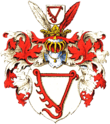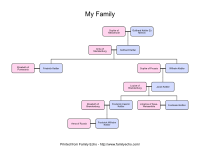Ketteler
Ketteler (also Kettler) is the name of a Baltic German noble family that originated in Westphalia.
| Ketteler Kettler | |
|---|---|
 | |
| Country | Germany, Latvia, Westphalia, Poland-Lithuania |
| Founded | 15th century |
| Founder | Gotthard Kettler (Polish branch) |
| Final ruler | Ferdinand Kettler |
| Titles | Duke of Courland and Semigallia Master of the Livonian Order |
| Deposition | 18th century |
| Cadet branches | German branch Polish branch |
Origin
Goswin Ketteler zu Assen (c. 1400 – c. 1471) divided the property with his younger brother Röttger around 1440. He built a new house on his part of the ground and called himself since then Kettler Neu Assen. He changed the background of his coat of arms from silver to gold – the so-called golden line. The silver line still spells Ketteler and is called the silver line Ketteler Alt Assen.

History
The Polish branch of the family rose to prominence during the Livonian War when Gotthard Kettler, the master of the Teutonic Order, created and inherited the Duchy of Courland and Semigallia from the Treaty of Vilnius (1561) as a vassal of the Grand Duchy of Lithuania from 1561 to 1569. It later became a vassal of the Polish-Lithuanian Commonwealth from 1569 to 1726, and it was incorporated into the Polish-Lithuanian Commonwealth by Sejm in 1726.
His family ruled the duchy until 1737, and the family became Polonized and married other members of the Szlachta. The family became increasingly powerful and had a chance of becoming one of the biggest magnates when Frederick William, Duke of Courland married Empress Anna of Russia. The family hoped that all their descendants would become emperors and that the duchy would become more powerful. Unfortunately, Frederick died soon after the wedding and this dream was crushed. Empress Anna never married again.
After Fredrick died, his uncle inherited the duchy, and when he died childless, his line became extinct. However, some people believe that the German branch still has descendants. When the family became extinct in Poland, Empress Anna's lover, Ernst Johann von Biron, became the new duke. He was succeeded by his son Peter von Biron, but he abdicated under pressure. During the Partitions of Poland, Catherine the Great succeeded the Biron family and merged the duchy with Russia. The duchy is now part of present-day Latvia.
Notable members
- Gotthard Kettler (also Ketteler; 2 February 1517 – 17 May 1587) was the last Master of the Livonian Order and the first Duke of Courland and Semigallia.
- Ferdinand Kettler (1 November 1655 – 4 May 1737) was the last Duke of Courland and Semigallia from the Kettler family.[1][2]
- Wilhelm Emmanuel Freiherr von Ketteler[3] (25 December 1811 – 13 July 1877) was a German theologian and politician who served as Bishop of Mainz; his social teachings became influential during the papacy of Leo XIII and his encyclical Rerum novarum.
- Clemens August Freiherr von Ketteler (22 November 1853 – 20 June 1900) was a German career diplomat; he was killed during the Boxer Rebellion, an event which prompted the Eight-Nation Alliance to declare war on China.
References
- Publications of the Scottish History Society. T. and A. Constable. p. 145. Retrieved 3 February 2017.
- History of the Eighteenth Century and of the Nineteenth Till the Overthrow of the French Empire: With Particular Reference to Mental Cultivation and Progress. Chapman and Hall. 1843. p. 294. Retrieved 3 February 2017.
- Regarding personal names: Freiherr was a title before 1919, but now is regarded as part of the surname. It is translated as Baron. Before the August 1919 abolition of nobility as a legal class, titles preceded the full name when given (Graf Helmuth James von Moltke). Since 1919, these titles, along with any nobiliary prefix (von, zu, etc.), can be used, but are regarded as a dependent part of the surname, and thus come after any given names (Helmuth James Graf von Moltke). Titles and all dependent parts of surnames are ignored in alphabetical sorting. The feminine forms are Freifrau and Freiin.